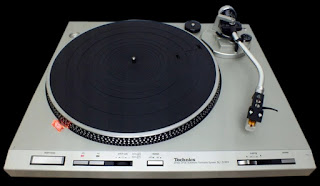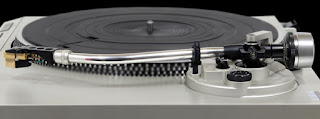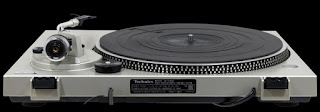Natural Sound AM/FM
Stereo Receiver
Combining
technology and musical sensitivity
The R-700 is a
direct development of Yamaha's unique design philosophy - an approach that aims
first and foremost at achieving the very highest in music reproduction
accuracy. In addition to electronic measurements, extensive subjective and
comparative listening tests by teams of music specialist monitor overall
progress toward our design goals as well as indicate which areas need to be
focussed on in order to maximize audible improvement in performance. These
uncompromising efforts have resulted in a number of significant design
innovations, as well as many subtle refinements which are continually improving
the reproduction quality of Yamaha audio products.
Every detail and
feature that can possibly affect sound quality - even to the slightest degree -
is given thorough consideration and testing to ensure that its incorporation in
the product will result in a positive benefit in terms of sound quality. The exciting
new Yamaha spatial expander control offered on the R-700, for example, lets you
"spread" the stereo sound field beyond the limits imposed by speaker
location to more accurately recreate the image of a live performance.
In short, our
approach combines both scientific method and musical sensitivity, allowing us
to apply our technology to those areas of each product where it will do the
most good; where you con hear it.
Super-Stereo Spatial
Expander
Advanced Yamaha
technology overcomes the last barrier to true high-fidelity reproduction. The
Spatial Expander puts "ambience" back in the reproduced sound - the
one element that conventional stereo cannot provide. With normal stereo
reproduction, the apparent locations of the various music instruments are
limited to the space between the left and right stereo speakers. Many so-called
"ambience enhancement" systems attempt to overcome this by adding an
extra pair of speakers - naturally requiring an extra amplifier plus the
separate ambience unit - thereby considerably increasing system cost and
inconvenience. The Yamaha Spatial Expander control, however, offers continously
variable expansion of the stereo sound image, putting a more realistic distance
between the musicians and creating an incredibly "live" sound without
the need for any extra speakers or amplification.
DC Configuration
Power Amplifier Section
Like the rest of the
R-700, its power amplifier section is specifically designed to amplify and
transmit the music waveform to your speakers without adding distortion. In
fact, the R-700's excellent 0,015% distortion figure is maintained even at full
50 watts per channel power output. This has been accomplished by using a
direct-coupled power amplifier design that eliminates capacitors in the signal
path so distortion caused by phase shift of the music signal is minimized. The
result is that you hear the music - not the amplifier - exactly the way it was
originally recorded.
Other features
Continuously
Variable Loudness Control
Record any source
while listening to any other
Subsonic and High
filters
lowNoise Phono
Equalizer
The Tuner a better
design for better sound
Station Locked
Synthesizer Tuning System Quartz PLL
Synthesizer tuners
actually have built-in noise, distortion and interference. Their internal
quartz oscillator and frequency dividers, although accurate, are generating
radio frequency signals within the tuner itself so some interference due to
leakage of these signals is virtually unavoidable.
Station Locked
Syntesizer Tuning Systems ICs
The R-700 tuner
section, on the other hand, uses Yamaha's unique StationLocked tuning system
which,in addition to being extremely accurate because it locks the tuner's
frequency directly onto that of the broadcast station, produces no interference
causing RF noise. You get pinpoint tuning accuracy plus pure, distortion-free
reception - precisely what a first-class tuner should provide.
Ultra-Linear Direct
FM Detector
Another impressive
Yamaha technological feature incorporated in the R-700 tuner section is the
ultra-linear direct FM detector circuit. It features greatly improved linearity
even when compared to the recent pulse-count detector designs, and a greatly simplified
signal path ensures that no noise or distortion is added to the music signal.
The is just one of the innovations incorporated in the R-700 tuner section that
help to raise FM reception to the level where if can justifiably be called
"high fidelity".
DC NFB PLL Multiplex
Demodulator
The purpose of the
multiplex demodulator is to separate the left and right chanels of the
composite stereo signal. Most high-performance tuners nowadays use a method
which involves turning the composite signal on and off at a 38 kHz rate.
Because the switches used for this are in the signal path, however, switching
distortion can be a problem. The multiplex demodulator of the R-700 solves this
by incorporating high-speed switches into the NFB loop of a high-slew-rate DC
amp., thereby throughly absorbing any trace of switching distortion. Overall,
this circuit provides excellent stereo separation, low harmonic and
intermodulation distortion, and superior transient response for the most
natural FM stereo reproduction.
Other Tuner
Features:
Sophisticated tuning
convenience, like pushbutton search tuning, and 5 FM/5 AM station preset
tuning.
Optimum reception in
any conditions, with automatic DX/Local switching, Auto Blend, and signal
quality meter.
Specifications
Audio Section
Minimum RMS Output
Power per Channel:
50 W (17 dBW) , 8 Ω , 20 -
20,000 Hz , 0,015% T.H.D.
55 W (17,4 dBW), 8 Ω , 1
kHz, 0,01% T.H.D.
Dynamic Headroom (8 Ω
): 2,5 dB
Total Harmonic
Distortion (30 - 20,000 Hz)
Phono MM to Rec Out
(3 V output) : 0,005%
Aux?Tape to SP Out (8 Ω , 1
W): 0,005%
Intermodulation
DIstortion Ratio
Aux/Tape to SP Out (8 Ω , 25
W): 0,01%
Power Bandwidth (8 Ω , 25
W, 0,02% T.H.D.) : 5 to 40,000 Hz
Damping Factor (8 Ω , 1
kHz): better than 40
Frequency Response (Aux/Tape to SP Out, 8 Ω ):
5 - 1000,000 Hz -1 dB
RIAA Deviation Phono
MM : ±0,5 dv
Input
Sensitivity/Impedance:
Phono MM : 2,5 mV/47 k Ω , 220 pF
Aux/Tape : 120 mV/47 k Ω
Input Sensitivity
(New IHF)
Phono MM : 0,35 mV
Aux/Tape : 17 mV
Max. Input Level
(0,01% T.H.D.)
Phono MM (20 -
20,000 Hz ) : 200 mV
Phono MM (1 kHz)
: 250 mV
Output
Level/Impedance:
Rec Out : 120 mV/470 Ω
Headphone Output
: 259 mW (0,015% T.H.D.)
Signal-to-Noise
Ratio (IHF A network)
Phono MM (5 mV,
input Shorted) : 85 dB
Aux/Tape (input
Shorted) : 100 dB
Signal-to-Noise
Ratio (new IHF)
Phono MM : 74 dB
Aux/Tape : 85 dB
Residual Noise
(IHF A Network) : 115 µV
Channel Separation (1 kHz, Vol -30 dB, 5.1 k Ω )
Aux/Tape to Other
Channel : -53 dB
Phono MM to Other
Channel : -53 dB
Tone Control
Characteristics
Bass (boost/cut)
: ±10 dB at 50 Hz
Treble (boost/cut)
: ±10 dB at 20 kHz
Turnover Frequencies
Bass : 350 Hz
Treble : 3,500 Hz
Filter
Characteristics
Low (Subsonic, EQ
Built-in): 15 Hz, -12 dB/oct
High : 8 kHz, -6 dB/oct
Continuous Loudness
Control (Level-Related Equalization)
Max.
Attenuation: -20 dB at 1 kHz
Rec Output
Level/Impedance (Fixed)
FM (100% mod. 1 kHz) : 500
mV/4,7 k Ω
AM (30% mod. 1 kHz) : 150
mV/4,7 k Ω
Tuner FM Section
Tuning Range: 87,6 to 108 MHz
50 dB Quieting
Sensitivity
Mono (DX) : 3,2 µV (15,3 dBf)
Stereo (DX, Auto
Blend) ; 25 µV (33,3 dBf)
Usable Sensitivity
IHF Mono (1 kHz, 100% mod.)
300 Ω
: 2,5
µV (13,2 dBf)
75 Ω : 1,25 µV (13,2 dBf)
Image Response Ratio
(98 MHz): 62 dB
IF Response Ratio
(98 MHz): 100 dB
Spurious Response
Ratio (98 MHz): 100 dB
AM Suppresion Ratio
(IHF): 65 dB
Capture
Ratio:(IHF): Local 1,5 dB; DX 2,2 dB
Alternate Channel
Selectivity (IHF): Local 30 dB; DX 82 dB
Selectivity (Two
Signals): DX 68 dB
Signal-to-Noise
Ratio
Mono : 84 dB
Stereo : 80 dB
Distortion Mono
100 Hz : Local 0,06%; DX 0,1%
1 kHz : Local 0,06%; DX 0,3%
6 kh : Local 0,08% DX 0,7%
Distortion Stereo
100 Hz : Local 0,07%; DX 0,1%
1 kHz : Local 0,07%; DX 0,5%
6 kh : Local 0,09% DX 0,8%
Intermodulation
DIstortion (IHF)
Mono : Local 0,07%; DX 0,5%
Stereo : Local 0,08%; DX 1%
Stereo Separation
(Local)
50 Hz : 44 dB
1 kHz : 50 dB
10 kHz : 45 dB
Frequency Response
50 Hz to 10 kHz ±0,3
dB
30 Hz to 15 kHz ±0,5
dB
Subcarrier Product
Ratio: 50 dB
Muting Threshold
(DX): 5 µV (19,2 dBf)
Auto-DX
Threshold: 30 µV (34,8 dBf)
Tuner AM Section
Tuning Range: 525 to 1,605 kHz
Usable Sensitivity
(loop antenna): 200 µV
Selectivity: 30 dB
Signal-to-Noise
Ratio: 50 dB
Image response
Ratio: 40 dB
Spurious response
ratio: 50 dB
Distortion (1
kHz): 0,3%
General
Semiconductors: 42 Transistors; 20 ICs; 3 FETs; 31 Diodes; 14
LEDs
Power
Requirements: 110 - 120 V, 220 - 240 V
50/60 Hz
Power
Consumption: 120 W
Dimensions (W x H x
D): 480 x 122 x 337 mm (18-7/8" x
4-3/4" x 13-1/4")
Weigth: 9 kg
(19 lbs 13 oz)
























